Related Research Articles
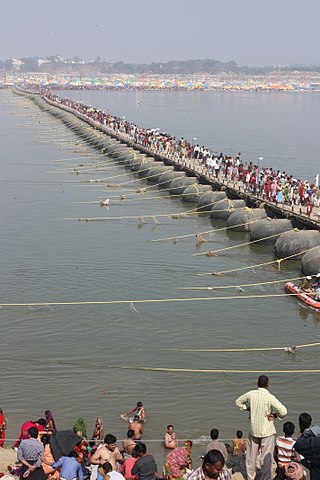
Kumbh Mela or Kumbha Mela is a major pilgrimage and festival in Hinduism, On February 4, 2019, Kumbh Mela witnessed the largest public gathering. It is celebrated in a cycle of approximately 12 years, to celebrate every revolution Brihaspati (Jupiter) completes, at four river-bank pilgrimage sites: Prayagraj, Haridwar (Ganges), Nashik (Godavari), and Ujjain (Shipra). The festival is marked by a ritual dip in the waters, but it is also a celebration of community commerce with numerous fairs, education, religious discourses by saints, mass gatherings of monks, and entertainment. The seekers believe that bathing in these rivers is a means to prāyaścitta for past mistakes, and that it cleanses them of their sins.

Makar(a) Sankranti, also referred to as Uttarayana, Makar, or simply Sankranti, is a Hindu observance and a festival. Usually falling on the date of 14 January annually, this occasion marks the transition of the sun from the zodiac of Sagittarius (dhanu) to Capricorn (makara). Since the sun has made this transition which vaguely coincides with moving from south to north, the festival is dedicated to the solar deity, Surya, and is observed to mark a new beginning. Many native multi-day festivals are organised on this occasion all over India.

Kumaon is a revenue and administrative division in the Indian State of Uttarakhand. It spans over the eastern half of the state and is bounded on the north by Tibet, on the east by Nepal, on the south by the state of Uttar Pradesh, and on the west by Garhwal. Kumaon comprises six districts of the state: Almora, Bageshwar, Champawat, Nainital, Pithoragarh and Udham Singh Nagar.

Vaisakhi, also known as Baisakhi, marks the first day of the month of Vaisakh and is traditionally celebrated annually on 13 April and sometimes 14 April. It is seen as a spring harvest celebration primarily in Punjab and Northern India. Whilst it is culturally significant as a festival of harvest, in many parts of India, Vaisakhi is also the date for the Indian Solar New Year.

The Pushkar Fair, also called the Pushkar Camel Fair or locally as Kartik Mela or Pushkar ka Mela is an annual multi-day livestock fair and cultural fête held in the town of Pushkar near Ajmer city in Ajmer district in. The fair starts with the Hindu calendar month of Kartik and ends on the Kartik Purnima, which typically overlaps with late October and early November in the Gregorian calendar. In 1998, over 1 million visitors came to Pushkar throughout the year. The Pushkar fair alone attracts over 200,000 visitors.
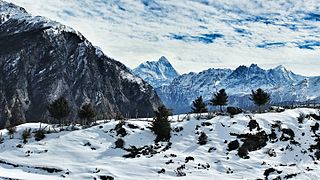
Uttarakhand, formerly known as Uttaranchal, is a state in northern India. The state is bordered by Himachal Pradesh to the northwest, Tibet to the north, Nepal to the east, Uttar Pradesh to the south and southeast, with a small part touching Haryana in the west. Uttarakhand has a total area of 53,566 km2 (20,682 sq mi), equal to 1.6 per cent of the total area of India. Dehradun serves as the state capital, with Nainital being the judicial capital. The state is divided into two divisions, Garhwal and Kumaon, with a total of 13 districts. The forest cover in the state is 45.4 per cent of the state's geographical area. The cultivable area is 16 per cent of the total geographical area. The two major rivers of the state, the Ganges and its tributary Yamuna, originate from the Gangotri and Yamunotri glaciers respectively.
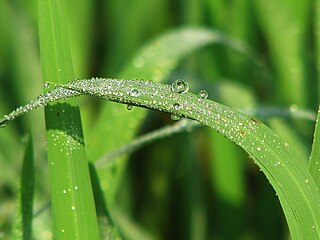
Poush is the 9th month of both the Bengali calendar and the Nepali calendar. It overlaps December and January of the Gregorian calendar. It is the first month of the winter season. This month marks the start of Winter in the Bengali calendar.
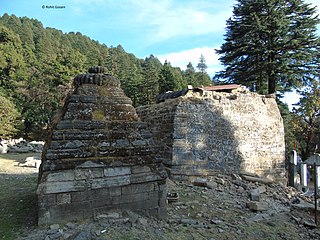
Pauri Garhwal is a district in the Indian state of Uttarakhand. Its headquarters is in the town of Pauri. It is sometimes referred to simply as Garhwal district, though it should not be confused with the larger Garhwal region of which it is only a part of.

Teej, literally meaning the "third" denoting the third day after the new moon when the monsoon begins as per the Hindu calendar, is a combined name for 3 Hindu festivals primarily dedicated to Hindu deities - the mother goddess Parvati and her male consort Shiva, mainly celebrated by married women and unmarried girls mostly in North India and Nepal to wish for the long life of their husband or future husband and to welcome the arrival of monsoon season with the singing, swings, dancing, enjoyment, prayer rituals and often fasting.

Poush Mela is an annual fair and festival that takes place in Santiniketan, in Birbhum District in the Indian state of West Bengal, marking the harvest season. Commencing on the 7th day of the month of Poush, the fair officially lasts for three days, although vendors may stay until the month-end as per the university regulations. From 2017 onwards, the fair lasted for six days. The key characteristic of this fair include live performances of Bengali folk music, such as baul, kirtan and Kobigan.

Yatra, in Indian-origin religions, Hinduism, Buddhism, Jainism and Sikhism, generally means a pilgrimage to holy places such as confluences of sacred rivers, sacred mountains, places associated with Hindu epics such as the Mahabharata and Ramayana, and other sacred pilgrimage sites. Visiting a sacred place is believed by the pilgrim to purify the self and bring one closer to the divine. The journey itself is as important as the destination, and the hardships of travel serve as an act of devotion in themselves.
The Pathani/Paatni (Kumaoni:पाटनी) are an ethnic group of the Attigoan and Kamsyar region of Gangolihat tehsil Pithoragarh district of the Kumaon Himalayas of the Indian state of Uttarakhand.

Kumaonis, also known as Kumaiye and Kumain, are an Indo-Aryan ethno-linguistic group who speak Kumaoni as their first-language and live mostly in Kumaon division in the state of Uttarakhand in India and parts of the Sudurpashchim Province in far western Nepal.

Gaura Parva is a Hindu festival celebrated by the people residing in Sudurpashchim province and parts of Karnali province of Nepal as well as in Kumaon region of Uttarakhand state of India. The festival commemorates the wedding of the goddess Gaura/Gauri (Parvati) to Shiva. The festival falls in the Hindu month of Bhadra (August/September).

Maghi is the regional name of the Hindu festival of Makar Sankranti celebrated in Punjab, Haryana Jammu division and Himachal Pradesh. In Himachal, the festival is also known as Maghi Saaji or Magha Ra Saza. In Bihar and Nepal it is also referred to as Maghi Parva or Maghi Sankranti. whereas it is known as Maghi Sangrand or Uttarain (Uttarayana) in Jammu and Sakrat in Haryana, Maghi is celebrated on first day of the month of Magh of Hindu Calendar. It follows on the heels of the mid-winter festival of Lohri which is marked by bonfires in North Indian fields and yards. The next morning Hindus see as an auspicious occasion for ritual bathing in ponds and rivers.
Punjabi festivals are various festive celebrations observed by Punjabis in Pakistan, India and the jairish alipreet Punjabi found in Kannada. The Punjabis are a diverse group of people from different religious background that affects the festivals they observe. According to a 2007 estimate, the total population of Punjabi Muslims is about 90 million, with 97% of Punjabis who live in Pakistan following Islam, in contrast to the remaining 30 million Punjabi Sikhs and Punjabi Hindus who predominantly live in India.
Here is a list of glossary of Culture of India in alphabetical order:
Harela is a Hindu festival celebrated in the Indian state of Uttarakhand and in some regions of Himachal Pradesh. This festival is very popular in the Kumaun region of Uttarakhand, and is celebrated by the name Harela (हरेला). This name is used in some places of Garhwal but, it is not commonly used, as the festival is celebrated as Mol-Sankranti (म्वोळ-संक्रांति) or as Rai-Sagrān (रै-सग्रान). It is called Hariyali/Rihyali in Kangra, Shimla and Sirmour regions, and Dakhrain in Jubbal and Kinnaur regions of Himachal Pradesh. This festival is celebrated on the first day of Shravan-Maas (Shravan-Sankranti/Kark-Sankranti), as per the Hindu Luni-Solar calendar. This festival marks the onset of the Rainy-Season (Monsoon). They pray for a good harvest and prosperity. Harela means "Day of Green", and Agriculture-based communities in the region consider it highly auspicious, as it marks the beginning of the sowing cycle in their fields. Multiple Kauthigs/Thols/Melas (Fairs) are also organized at this festival.
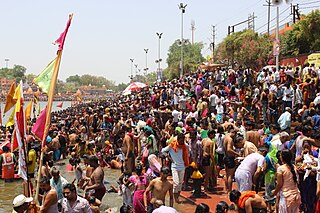
Ujjain Simhastha is a Hindu religious mela held every 12 years in the Ujjain city of Madhya Pradesh, India. The name is also transliterated as Sinhastha or Singhastha. In Hindi, the fair is also called Simhasth or Sinhasth. The name derives from the fact that it is held when the Jupiter is in Leo.